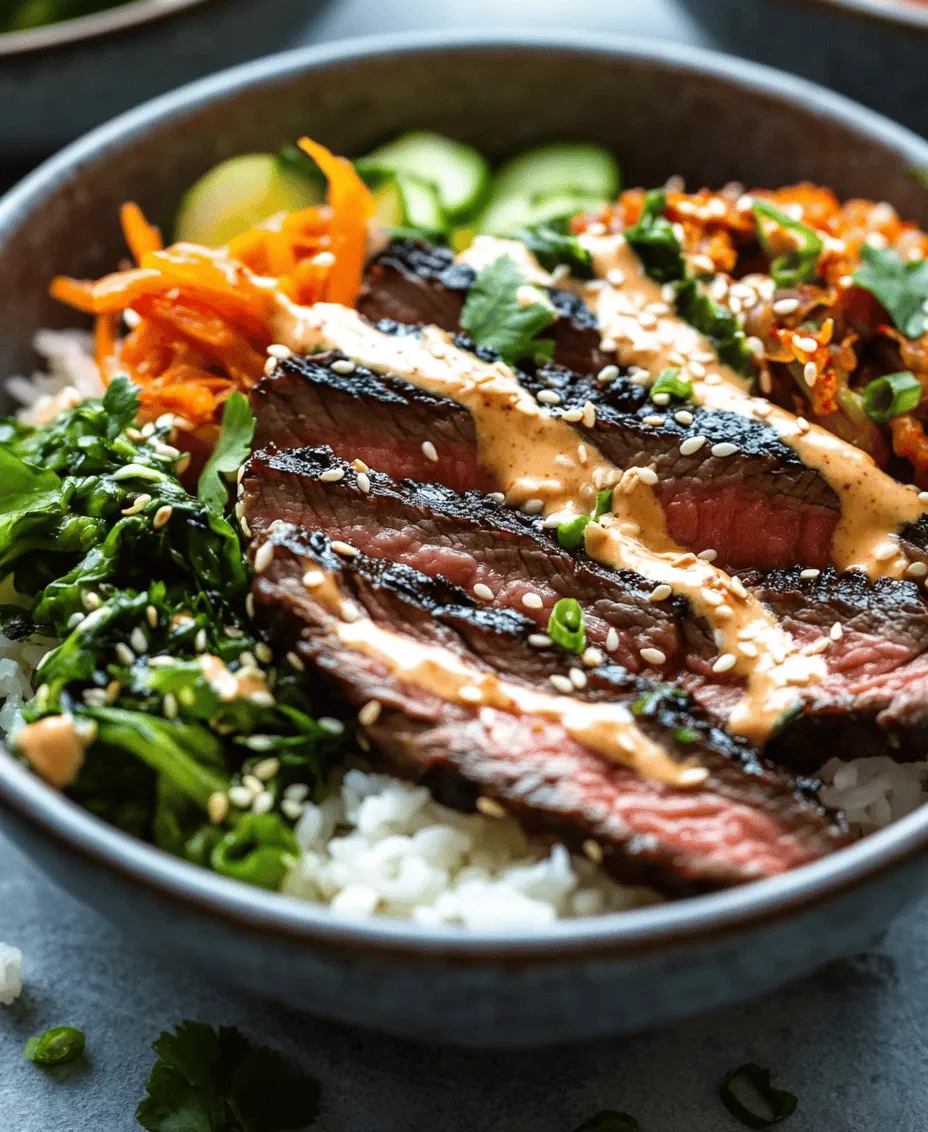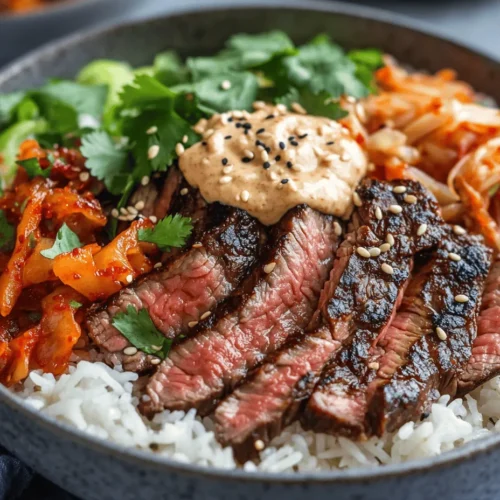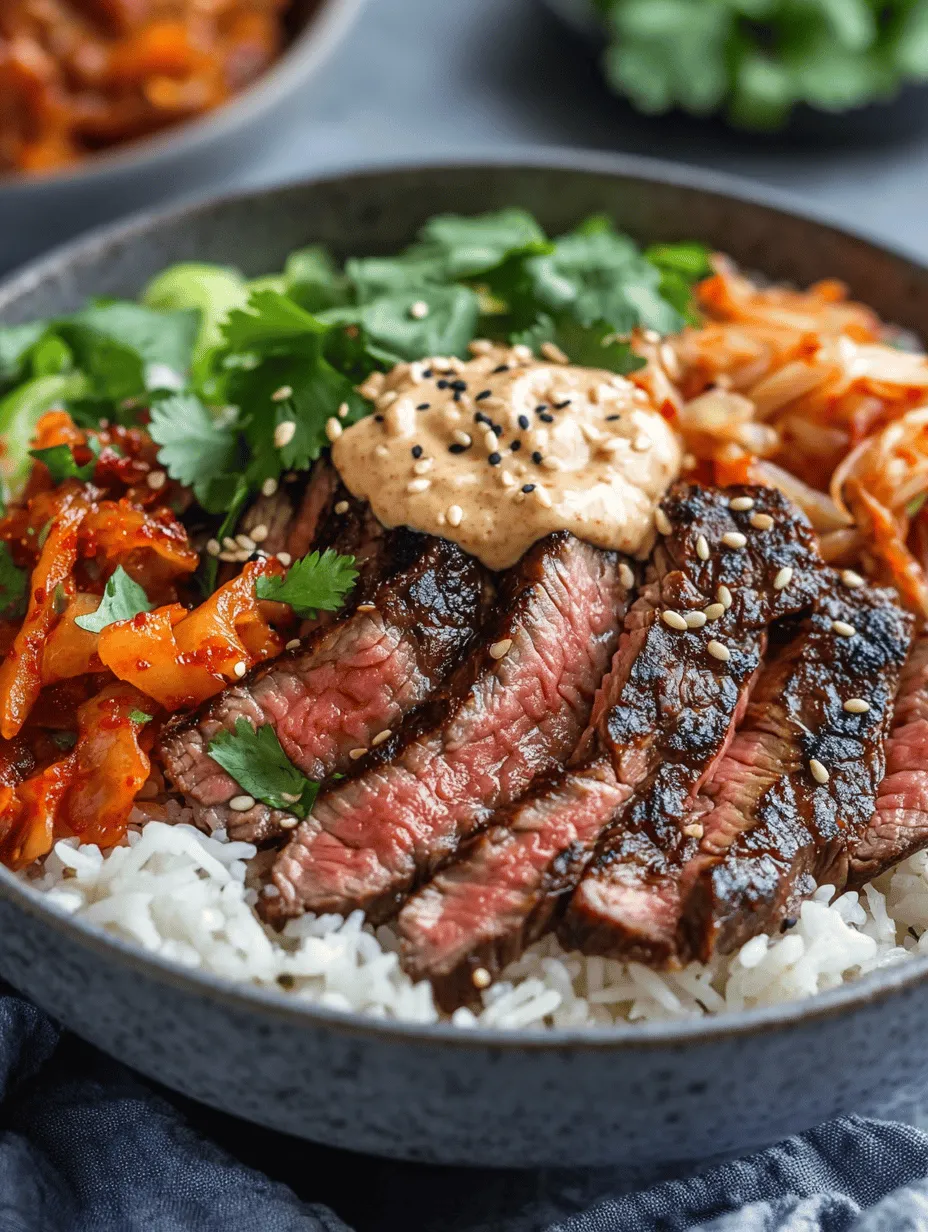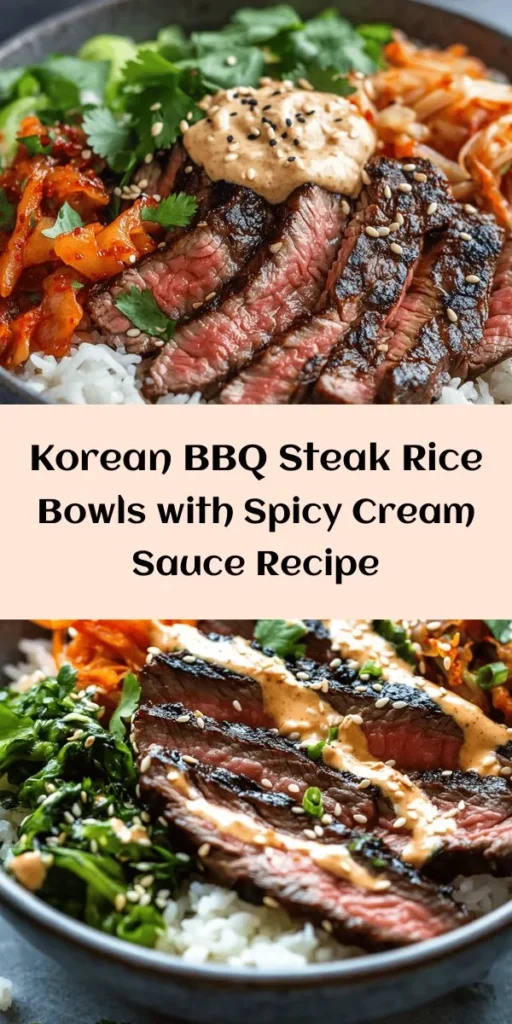Introduction to Korean BBQ Steak Rice Bowls with Spicy Cream Sauce
In recent years, Korean BBQ has become a culinary phenomenon, captivating food lovers around the globe with its unique flavors, vibrant presentations, and communal dining experience. This cuisine, rich in tradition and taste, showcases a delightful array of dishes that celebrate the harmony of flavors—sweet, savory, spicy, and tangy. Among these, Korean BBQ Steak Rice Bowls with Spicy Cream Sauce stand out as a perfect fusion of classic Korean grilling techniques and modern flavors, making them a must-try for both seasoned chefs and novice cooks alike.
This dish encapsulates the essence of Korean BBQ, featuring tender, marinated steak served over a bed of fluffy jasmine rice and topped with a creamy, spicy sauce that elevates the entire experience. The appeal of Korean BBQ Steak Rice Bowls lies not only in their deliciousness but also in their adaptability; they can be tailored to suit various dietary preferences and personal tastes. As we delve into this recipe, we will explore how the careful balance of flavors and textures contributes to its popularity and why it should have a place on your dining table.
One of the hallmarks of Korean cooking is the meticulous attention to balancing flavors. Each ingredient plays a vital role, complementing and enhancing the others. In this dish, the savory marinated steak harmonizes beautifully with the sweet and spicy notes of the sauce, while the freshness of mixed vegetables adds a burst of color and nutrition. This balance not only makes the dish visually appealing but also ensures that each bite is a delightful experience.
Furthermore, Korean BBQ Steak Rice Bowls are not just a treat for the taste buds; they also offer numerous health benefits. Flank steak is a lean source of protein, while mixed vegetables provide essential vitamins and minerals. The inclusion of kimchi, a staple in Korean cuisine, introduces probiotics that promote gut health, making this dish both nourishing and delicious. Its versatility allows for various customizations, catering to different dietary needs, whether you prefer more vegetables, a different protein, or a milder sauce.
Understanding the Ingredients
Detailed Breakdown of the Key Ingredients Used in the Recipe
To create the perfect Korean BBQ Steak Rice Bowls with Spicy Cream Sauce, it’s essential to understand each ingredient’s role in the dish. Let’s explore the key components that come together to create this flavorful meal.
Flank Steak: Nutritional Benefits and Characteristics
Flank steak is the star of this dish, known for its rich flavor and tender texture when cooked correctly. This cut of meat comes from the abdominal muscles of the cow, making it leaner than other steak cuts. It’s an excellent source of protein, iron, and B vitamins, crucial for energy and overall health. When marinated and grilled, flank steak becomes incredibly tender and absorbs flavors beautifully, making it a popular choice in Korean BBQ.
Marinade Components: Explanation of Each Ingredient’s Role and Flavor Contribution
The marinade is fundamental to achieving the signature taste of Korean BBQ. Typically, it includes ingredients such as soy sauce, sesame oil, garlic, ginger, sugar, and black pepper. Each component adds depth to the flavor profile:
– Soy Sauce: Provides a savory umami flavor that enhances the steak’s natural taste.
– Sesame Oil: Adds a nutty aroma and richness, complementing the other flavors.
– Garlic and Ginger: Infuse the meat with aromatic qualities, bringing warmth and zest.
– Sugar: Balances the saltiness of the soy sauce with a subtle sweetness, which caramelizes beautifully during grilling.
– Black Pepper: Introduces a hint of spice that rounds out the flavor.
The combination of these ingredients not only tenderizes the steak but also creates a well-rounded flavor that is distinctly Korean.
Jasmine Rice: Why It’s the Best Choice for This Dish
When it comes to the base of the rice bowl, jasmine rice is the ideal choice. This aromatic rice variety is known for its slightly floral fragrance and fluffy texture, which pairs perfectly with the bold flavors of the marinated steak and spicy cream sauce. Its ability to absorb flavors makes jasmine rice an excellent vehicle for the dish’s savory components, ensuring that every bite is as delicious as the last. Additionally, jasmine rice is gluten-free and provides a good source of carbohydrates, making it a satisfying option.
Mixed Vegetables: Importance of Color and Nutrition
A vibrant mix of vegetables not only enhances the visual appeal of the dish but also contributes essential nutrients. Common choices include bell peppers, carrots, and broccoli, each adding a splash of color and crunch. These vegetables are rich in vitamins, minerals, and fiber, making them a healthy addition to the meal. They also provide a refreshing contrast to the rich flavors of the steak and sauce, balancing the dish perfectly.
Kimchi: Cultural Significance and Health Benefits
No Korean meal is complete without kimchi, a traditional side dish made from fermented vegetables, most commonly napa cabbage and radishes. Kimchi is not just a flavorful accompaniment; it also boasts numerous health benefits. Rich in probiotics, vitamins A, B, and C, and antioxidants, kimchi can support gut health, boost immunity, and even aid in digestion. Its tangy and spicy profile adds an additional layer of flavor to the rice bowl, making it a crucial component of this dish.
Spicy Cream Sauce: Balance of Flavors and Versatility in Use
The spicy cream sauce is where the dish truly comes alive, harmonizing the elements of spice, creaminess, and richness. This sauce typically includes ingredients such as mayonnaise, sriracha, and lime juice, creating a unique blend of flavors. The mayonnaise provides a creamy base, while sriracha adds heat and flavor depth. Lime juice introduces acidity, cutting through the richness and brightening the overall taste.
The beauty of this sauce lies in its versatility; it can be adjusted to suit individual spice preferences. Whether you prefer a mild kick or a fiery sensation, the sauce can be tailored to achieve your desired level of heat. Additionally, it can be used in various dishes outside of the rice bowl, making it a fantastic condiment to have on hand.
The Art of Marinating the Steak
Marinating is a crucial step in preparing Korean BBQ Steak Rice Bowls, as it allows the flavors to penetrate the meat and enhances its tenderness. Properly marinated steak will be flavorful throughout, making each bite a delectable experience. Here’s how to perfect the art of marinating your flank steak.
Step-by-Step Guide on How to Prepare the Marinade
1. Gather your Ingredients: Start by assembling all the ingredients needed for the marinade. This typically includes soy sauce, sesame oil, minced garlic, grated ginger, sugar, and black pepper.
2. Mix the Marinade: In a bowl, combine the soy sauce, sesame oil, garlic, ginger, sugar, and black pepper. Whisk until the sugar is dissolved, and the mixture is well combined.
3. Prepare the Steak: Trim any excess fat from the flank steak, as this can lead to flare-ups during grilling. Pat the meat dry with paper towels to help the marinade adhere better.
4. Marinate the Steak: Place the steak in a resealable plastic bag or a shallow dish. Pour the marinade over the steak, ensuring that it is evenly coated. Seal the bag or cover the dish and refrigerate.
Tips on Marinating Time and Temperature for Optimal Results
For the best flavor and tenderness, marinate the steak for at least 30 minutes, but ideally, aim for 2-4 hours. If you have more time, marinating overnight can yield even better results. However, avoid marinating for more than 24 hours, as the acidity from the marinade can break down the meat too much, resulting in a mushy texture.
Discussing the Role of Each Marinade Component in Tenderizing and Flavoring the Meat
Each ingredient in the marinade serves a specific purpose:
– Soy Sauce: The salt in the soy sauce helps to break down the proteins in the meat, resulting in a more tender texture.
– Sesame Oil: This not only adds flavor but also contributes to the overall juiciness of the steak.
– Garlic and Ginger: Both ingredients not only enhance flavor but also have natural tenderizing properties.
– Sugar: As it caramelizes during grilling, sugar contributes to the delicious crust on the outside of the steak.
By understanding the role of each component, you can appreciate the intricacies of flavor and texture that make Korean BBQ Steak Rice Bowls an unforgettable dish.
Creating the Spicy Cream Sauce
The spicy cream sauce is a defining element of this recipe, providing a creamy texture and a kick of heat that ties the dish together. Here’s how to prepare this versatile sauce.
Detailed Instructions for Preparing the Sauce
1. Gather Ingredients: You will need mayonnaise, sriracha, lime juice, and a pinch of salt.
2. Combine Ingredients: In a small bowl, mix together the mayonnaise and sriracha. Start with a tablespoon of sriracha and adjust according to your spice preference.
3. Add Lime Juice: Squeeze fresh lime juice into the mixture, stirring to combine. This will add brightness and balance the richness of the mayonnaise.
4. Season: Add a pinch of salt to enhance the flavors. Taste and adjust as necessary, adding more sriracha for heat or lime juice for acidity.
Analysis of the Flavor Profile: Balancing Heat and Creaminess
The key to a successful spicy cream sauce lies in the balance between heat and creaminess. The creamy base allows the heat from the sriracha to shine without overwhelming the palate. It’s essential to taste and adjust the sauce, ensuring it complements the steak without overshadowing its flavor.
Suggestions for Adjusting Spice Levels to Suit Different Palates
If you’re cooking for a crowd or family with varying spice tolerances, consider these adjustments:
– For a milder sauce: Reduce the amount of sriracha, or substitute it with a mild chili sauce.
– For extra kick: Add a dash of cayenne pepper or a few slices of fresh jalapeño to the sauce.
– For a tangier flavor: Increase the lime juice for a zesty twist.
This sauce is not only perfect for the rice bowls but can also be drizzled on salads, used as a dip for veggies, or served alongside grilled meats.
Grilling the Steak to Perfection
The final step in preparing your Korean BBQ Steak Rice Bowls is grilling the marinated flank steak. Grilling enhances the flavors developed during marination and adds a delicious char to the meat. Here’s how to achieve perfectly grilled steak every time.
Preparing the Grill
1. Preheat the Grill: Heat your grill to high heat. If using a charcoal grill, ensure the coals are glowing and covered with ash; for gas grills, allow it to preheat for about 10-15 minutes.
2. Oil the Grate: To prevent sticking, lightly oil the grill grate using a paper towel dipped in vegetable oil, held with tongs.
Grilling Instructions
1. Remove Steak from Marinade: Take the marinated steak out of the fridge and let it sit at room temperature for about 15-20 minutes before grilling.
2. Grill the Steak: Place the steak on the grill and cook for about 4-5 minutes on each side for medium-rare, depending on the thickness of the steak. Use a meat thermometer to check for doneness; medium-rare should read 130-135°F.
3. Rest the Steak: Once grilled to perfection, remove the steak from the grill and let it rest for at least 5 minutes. This allows the juices to redistribute, ensuring a juicy and flavorful steak.
Slicing and Serving
After resting, slice the steak against the grain into thin strips. This technique ensures tenderness and makes it easier to eat. Serve the sliced steak over jasmine rice, topped with the spicy cream sauce and a generous helping of mixed vegetables and kimchi for a truly satisfying meal.
In the next part of this article, we’ll explore additional serving suggestions, garnishes, and variations on this delicious Korean BBQ Steak Rice Bowl recipe. Stay tuned for more ways to enjoy this flavorful dish!

Best Practices for Grilling Flank Steak
Grilling flank steak can transform your Korean BBQ Steak Rice Bowls from good to spectacular. Here are some best practices to ensure perfect results:
1. Choosing the Right Cut: Flank steak is known for its rich flavor and relatively lean profile. It’s essential to select a high-quality cut, ideally with good marbling, which contributes to tenderness and flavor.
2. Marinating: Allow your steak to marinate for at least 30 minutes, but preferably for a few hours or overnight. A marinade with soy sauce, sesame oil, garlic, and ginger will infuse the meat with authentic Korean flavors.
3. Preheating the Grill: Preheat your grill to high heat. A hot grill sears the meat quickly, locking in juices and creating a beautiful crust.
4. Grilling Technique: Place the steak on the grill at a 45-degree angle to the grates. This enhances the flavor through better searing and creates appealing grill marks. Avoid flipping the steak too often; let it develop a crust before turning.
5. Temperature Settings and Cooking Times: For medium-rare, aim for an internal temperature of 130-135°F (54-57°C). This usually takes about 4-6 minutes per side, but depends on the thickness of your steak. Use an instant-read thermometer for accuracy.
6. Importance of Resting the Meat: After grilling, let your flank steak rest for 5-10 minutes before slicing. This crucial step allows the juices to redistribute, making the meat more succulent.
7. Slicing Techniques for Tenderness: When slicing the steak, cut against the grain. This shortens the muscle fibers, resulting in a more tender bite. Aim for ¼ inch thick slices for optimal texture.
8. Visual Cues to Look For When Grilling Steak: Look for a deep brown crust on the outside of the steak, which indicates proper searing. The meat should also feel firm but slightly springy when pressed, suggesting it’s cooked to your desired doneness.
Sautéing the Vegetables
The vegetables are a vital part of your Korean BBQ Steak Rice Bowls, adding texture and flavor. Here’s how to prepare them:
1. Choosing the Right Vegetables: Opt for a mix of bell peppers, zucchini, carrots, and snap peas. These vegetables not only offer a colorful presentation but also a delightful crunch. You could also add mushrooms for an earthy flavor or bok choy for an authentic Asian touch.
2. Techniques for Stir-Frying: Heat a tablespoon of oil in a wok or large skillet over medium-high heat. When the oil shimmers, add your vegetables. Stir-frying should be quick and intense to preserve the nutrients. Cook for about 3-5 minutes, tossing frequently until vegetables are just tender but still crisp.
3. Seasoning Tips for Enhancing Vegetable Flavors: Add a splash of soy sauce, sesame oil, or a sprinkle of salt and pepper towards the end of cooking. A dash of rice vinegar can also brighten the flavors without overpowering the natural sweetness of the vegetables.
Assembling the Korean BBQ Steak Rice Bowls
Now that your steak and vegetables are ready, it’s time to assemble your rice bowls. Follow these steps for a visually appealing dish:
1. Base Layer: Start with a generous scoop of cooked rice (white or brown) at the bottom of each bowl. This will serve as the base for your other ingredients.
2. Layering the Steak: Place the sliced flank steak on top of the rice. Arrange the slices neatly, overlapping slightly for an enticing presentation.
3. Adding Vegetables: Next, add your sautéed vegetables. Position them artfully around the steak to create vibrant sections of color.
4. Drizzling the Spicy Cream Sauce: Generously drizzle your spicy cream sauce over the steak and vegetables. You can use a squeeze bottle or a spoon for precision.
5. Final Touches: For an extra touch, sprinkle sesame seeds and finely sliced green onions over the top. Feel free to add fresh cilantro or a few slices of radish for added flavor and color.
Tips on Portioning for Balanced Meals: Aim for a balanced plate with equal parts protein, carbohydrates, and vegetables. This not only looks appealing but ensures that each bite is packed with nutrients.
6. Suggestions for Alternative Toppings and Garnishes: Consider adding pickled vegetables, a fried egg, or even kimchi for an authentic Korean touch. Each of these adds unique flavors and textures, enhancing the overall dish.
Serving Suggestions and Pairings
To elevate your Korean BBQ Steak Rice Bowls, consider these serving suggestions and pairings:
1. Ideas for Side Dishes: A refreshing cucumber salad or a light seaweed salad can complement the richness of the steak. Alternatively, serve with a simple miso soup for a comforting addition.
2. Recommended Beverages: Pair your meal with a crisp lager or a fruity soju. For a non-alcoholic option, iced green tea or a refreshing Asian pear soda can enhance the dining experience.
3. Cultural Significance of How Korean BBQ is Served Traditionally: In Korea, BBQ is often enjoyed family-style, with various side dishes called banchan served alongside the main meal. Emulating this can create a more authentic dining experience at home.
Nutritional Analysis of the Dish
Understanding the nutritional aspects of your meal can help you enjoy it even more. Here’s a breakdown:
1. Calories, Macronutrients, and Vitamins per Serving: A serving of Korean BBQ Steak Rice Bowl (with 4 oz of flank steak, 1 cup of cooked rice, and a mix of sautéed vegetables) typically contains around 600-700 calories. It provides approximately 40g of protein, 80g of carbohydrates, and 20g of fat. The dish is rich in vitamins A and C from the vegetables, along with several B vitamins from the rice.
2. Health Benefits of Incorporating Such Dishes into a Balanced Diet: This dish is a great source of protein, essential for muscle repair and growth. The vegetables provide fiber and antioxidants, promoting digestive health and reducing inflammation.
3. Discussion on How to Make the Dish Healthier, if Desired: To reduce calories, consider using cauliflower rice instead of white rice for a low-carb option. You can also use leaner cuts of meat or reduce the amount of sauce to control fat content.
Conclusion: Embracing Korean Cuisine at Home
Creating Korean BBQ Steak Rice Bowls at home is not just about the meal; it’s an experience to be savored. The combination of marinated steak, crunchy vegetables, and a spicy cream sauce brings a delightful array of flavors and textures.
Embrace the opportunity to experiment with different ingredients and customize your bowls to your taste. Korean cuisine offers a rich tapestry of flavors that can easily be recreated in your kitchen, making it accessible for home cooks of all levels.
As you delve into these recipes, you’ll find that the joy of cooking Korean dishes lies in their communal nature, inviting family and friends to gather around the table. So fire up the grill, gather your ingredients, and embark on a culinary journey that celebrates the vibrant culture and flavors of Korea right in your home.



